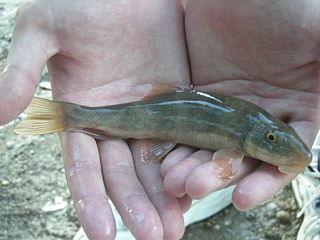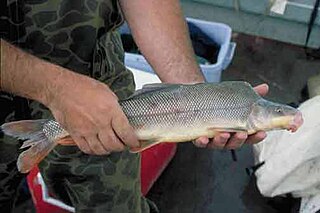
The Colorado River is one of the principal rivers in the Southwestern United States and in northern Mexico. The 1,450-mile-long (2,330 km) river, the 5th longest in the United States, drains an expansive, arid watershed that encompasses parts of seven U.S. states and two Mexican states. The name Colorado derives from the Spanish language for "colored reddish" due to its heavy silt load. Starting in the central Rocky Mountains of Colorado, it flows generally southwest across the Colorado Plateau and through the Grand Canyon before reaching Lake Mead on the Arizona–Nevada border, where it turns south toward the international border. After entering Mexico, the Colorado approaches the mostly dry Colorado River Delta at the tip of the Gulf of California between Baja California and Sonora.

Lake Powell is an artificial reservoir on the Colorado River in Utah and Arizona, United States. It is a major vacation destination visited by approximately two million people every year. It is the second largest artificial reservoir by maximum water capacity in the United States behind Lake Mead, storing 24,322,000 acre-feet (3.0001×1010 m3) of water when full. However, Lake Mead has fallen below Lake Powell in size several times during the 21st century in terms of volume of water, depth and surface area.

The Virgin River is a tributary of the Colorado River in the U.S. states of Utah, Nevada, and Arizona. The river is about 162 miles (261 km) long. It was designated Utah's first wild and scenic river in 2009, during the centennial celebration of Zion National Park.

The Price River is a 137-mile-long (220 km) southeastward flowing river in Carbon, Utah and Emery counties in eastern Utah. It is a tributary to the Green River, itself a tributary to the Colorado River.

Catostomus is a genus of fish belonging to the family Catostomidae, commonly known as suckers. This genus of fish usually lives in freshwater basins. Most members of the genus are native to North America, but C. catostomus is also found in Russia.

The roundtail chub is a cyprinid fish in the genus Gila, of southwestern North America. It is native to the Colorado River drainage basin, including the Gila River and other tributaries, and in several other rivers. It is part of the “robusta complex”, which includes the Gila robusta robusta, G.r. grahami, and G.r. seminuda.

The Utah sucker is a species of freshwater fish in the family Catostomidae found in the upper Snake River and the Lake Bonneville areas of western North America where it lives in a wide range of habitats. It is a large sucker growing up to 25 in (64 cm) long. It is generally blackish above, vaguely streaked and blotched, with a white belly. A narrow rosy lateral band extends backwards from the head. The mouth has thick lips and is on the underside of the head. Some populations are in decline because of anthropogenic factors but overall this fish is not threatened.

The razorback sucker is a suckerfish found in rivers and lakes in the southwestern United States and formerly northwestern Mexico. It can grow to 91 cm (3 ft) in length and is recognisable by the keel between its head and dorsal fin. It used to inhabit much of the Colorado River Basin but commercial fishing, river damming, and habitat loss have caused great declines in populations. It is now restricted to the Colorado River upstream of the Grand Canyon and to four reservoirs, Lake Mead, Lake Mohave, Lake Havasu, and Lake Powell.

The humpback chub is a federally protected fish that lived originally in fast waters of the Colorado River system in the United States. This species takes its name from the prominent hump between the head and dorsal fin, which is thought to direct the flow of water over the body and help maintain body position in the swift currents of the Colorado river. The body is almost entirely scaleless, retaining only about 80 mid-lateral scales along the lateral line. The fish is very streamlined, with a thin caudal peduncle and a deeply forked tail. The back is a light olive gray, the sides silver, and the belly white. The dorsal fin usually has nine rays, and the anal fin 10 or more. Maximum recorded length is 38 cm.
The Colorado pikeminnow is the largest cyprinid fish of North America and one of the largest in the world, with reports of individuals up to 6 ft (1.8 m) long and weighing over 100 pounds (45 kg). Native to the Colorado River Basin of the southwestern United States and adjacent Mexico, it was formerly an important food fish for both Native Americans and European settlers. Once abundant and widespread in the basin, its numbers have declined to the point where it has been extirpated from the Mexican part of its range and was listed as endangered in the US part in 1967, a fate shared by the three other large Colorado Basin endemic fish species: bonytail chub, humpback chub, and razorback sucker. The Colorado pikeminnow is currently listed as vulnerable by the IUCN, while its NatureServe conservation status is "critically imperiled".

The bonytail chub or bonytail is a cyprinid freshwater fish native to the Colorado River basin of Arizona, California, Colorado, Nevada, New Mexico, Utah and Wyoming in the southwestern United States; it has been extirpated from the part of the basin in Mexico. It was once abundant and widespread in the basin, its numbers and range have declined to the point where it has been listed as endangered since 1980 (ESA) and 1986 (IUCN), a fate shared by the other large Colorado basin endemic fish species like the Colorado pikeminnow, humpback chub, and razorback sucker. It is now the rarest of the endemic big-river fishes of the Colorado River. There are 20 species in the genus Gila, seven of which are found in Arizona.
Rough fish is a term used by some United States state agencies and anglers to describe fish that are less desirable to sport anglers within a defined region. The term usually refers to larger game fish species that are not commonly eaten, are too rare to be commonly encountered, or are not favorably sought by anglers for sporting purposes. Many of these species are actually very important in the commercial fishing industry, where they make up the bulk of commercial food fish catches in inland freshwater bodies.

The bluehead sucker is endemic to the intermountain Western US. A total of 23 members of the genus Catostomus has been found in North America. C. discobolus and C. yarrowi are two sister species that have very similar Arizona habitats.

The Sonora Sucker, Catostomus insignis, is a medium-sized catostomid fish with 16 other species in the genus scattered throughout North America. This species is remarkably similar in appearance to the Yaqui Sucker.
The Little Colorado River Sucker or Little Colorado sucker is a scientifically undescribed species of North American freshwater fish very similar to the flannelmouth sucker but without the flannelmouth's distinct fleshy lips. The Little Colorado sucker is native to the upper region of the Little Colorado River in Arizona, but was also introduced into the Salt River.
Catostomus discobolus jarrovii is a species of fish only found in Arizona and New Mexico in the United States.

The desert sucker or Gila Mountain sucker, is a freshwater species of ray-finned fish in the sucker family, endemic to the Great Basin and the Colorado River Basin in the United States. It inhabits rapids and fast-flowing streams with gravelly bottoms. It is a bi-colored fish with the upper parts olive brown to dark green, and the underparts silvery-tan or yellowish. The head is cylindrical, tapering to a thick-lipped mouth on the underside. This fish can grow to 31 in (79 cm) in Arizona but is generally only about half this size elsewhere. There are three subspecies, found in different river basins, and some authorities allot this species its own genus Pantosteus.

The Tahoe sucker is a freshwater cypriniform fish inhabiting the Great Basin region of the Western United States.

The Klamath smallscale sucker(Catostomus rimiculus), also known as the Jenny Creek sucker, is a species of ray-finned fish in the family Catostomidae. It is a freshwater fish that primarily inhabits the Trinity and Klamath River watersheds, as well as the overall region of the Klamath Basin in general. Within the Klamath Basin, they inhabit the area along with three other sucker fish: the Lost River sucker, shortnose sucker, and the Klamath largescale sucker. These fish can vary in length from 35 cm to 50 cm, and usually have a lifespan of around 9-15 years. They often form mixed schools with speckled dace, sculpins, and juvenile steelhead.

The Rio Grande sucker is a North American freshwater fish in the family Catostomidae. It has a typical bottom-feeding phenotype and fills lower trophic levels alongside Rio Grande cutthroat trout and Rio Grande chub species. It is smaller sized in comparison to its other family members, with females being the larger between sexes. Coloration tends to benefit the species due to counter-shading patterns. It is endemic to the Rio Grande basin and was once common throughout. The species has maintained a population in New Mexico, Colorado, Arizona, and Northern Mexico, but has faced challenges from the pressure of non-native species, habitat loss, degradation, and a variety of other aquatic ecosystem changes. There is current pressure from environmental organizations to federally list the species as threatened or endangered.
















